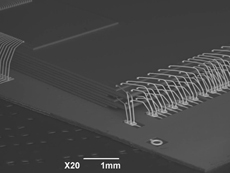32GB flash chips target mobile devices
Aug 7, 2008 — by LinuxDevices Staff — from the LinuxDevices Archive — 46 views Toshiba has announced new NAND flash memory devices said to offer the highest densities ever. The 32GB devices use chips built on 43 nanometer process technology, integrate controllers for standard interfaces, and target mobile phones, handhelds, and PNDs (personal navigation devices).
Toshiba has announced new NAND flash memory devices said to offer the highest densities ever. The 32GB devices use chips built on 43 nanometer process technology, integrate controllers for standard interfaces, and target mobile phones, handhelds, and PNDs (personal navigation devices).
(Click here for a larger view of Toshiba's 32GB flash memory devices)
The new 32GB devices combine eight 32Gbit (4GB) NAND chips fabricated with 43nm process technology. According to Toshiba, they also include integrated controllers that comply with the JEDEC/MMCA (Jedec Solid State Technology Association/MultiMediaCard Association) Ver. 4.3 and SDA (SD Card Association) Ver. 2.0 high-speed memory standards for memory cards.

Taken with a electron microscope, this photo shows the new 32GB flash memory devices' internal structure
Source: Toshiba
Because these controllers standardize essential functions, such as block management and error correction, time to market for new products incorporating the higher-capacity flash will be minimized, claims Toshiba. Thus, phones and other small devices sporting 32GB of memory could appear shortly after mass production of the new memory devices begins — set for the fourth quarter, Toshiba says.
The 32GB devices come in 169-ball FBGA (fine-pitch ball grid array) packages measuring 18 x 14 x 1.4mm. Part number THGBM1G8D8EBAI2 features a JEDEC/MMCA-compatible controller, while part number THGVS4G8D8EBAI2 features an SDA-compatible controller.
According to Toshiba, the SDA-compatible device complies with the SD Class 4 specification, meaning that memory reads and writes reach a minimum speed of 4MB/sec. The JEDEC/MMCA-compatible device, on the other hand, is apparently faster. Toshiba cites writes of 18 MB/sec. in sequential/interleaved mode, and reads of up to 2.0MB/sec. sequentially.
Both parts require a power supply voltage from 2.7V to 3.6V, and operating temperature ranges from -25 to 85 deg. C.
Background
Toshiba's new memory devices will apparently make it simple to ship phones and PNDs with comparatively massive amounts of flash memory. However, manufacturers have historically skimped on the amount of RAM and flash they supply.
In the case of phones, this may be due to the influence of cost-conscious carriers, who sometimes do not even deign to specify the amount of storage their handsets include. In addition, SD and microSD slots admittedly make it simple for consumers to add flash storage to devices after the fact.
 Samsung's SGH-i900 Omnia (Click image for further information) |
Apple has jarred the status quo, however, by shipping its iPhones with up to 16GB of built-in flash storage. Earlier this year, Samsung followed in its footsteps by launching the SGH-i900 Omnia, a Windows Mobile 6.1 phone that also is available with 16GB of flash. Unlike the iPhone, the Omnia, pictured at right, includes a microSD slot too.
Another trendsetter, HTC, has also increased flash rations, though less dramatically. In addition to its VGA-resolution touchscreen, the company's latest Touch Diamond comes with 4GB of flash.
Meanwhile, consumer demand for more memory seems to be growing, according to a recent report by ABI Research. While unit sales of phones have been flat, “the mass market's fascination with getting the latest and greatest handset shows no sign of abating,” according to research director Kevin Burden.
Further information
Toshiba's new 32GB NAND flash memory devices will be sampling in September, and mass production will begin in the fourth quarter, according to the company.
This article was originally published on LinuxDevices.com and has been donated to the open source community by QuinStreet Inc. Please visit LinuxToday.com for up-to-date news and articles about Linux and open source.